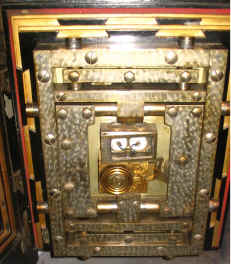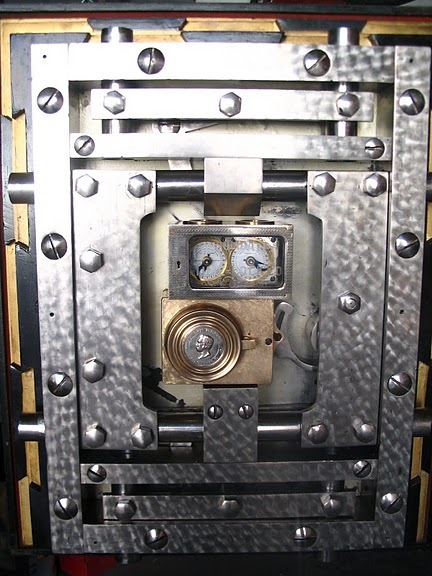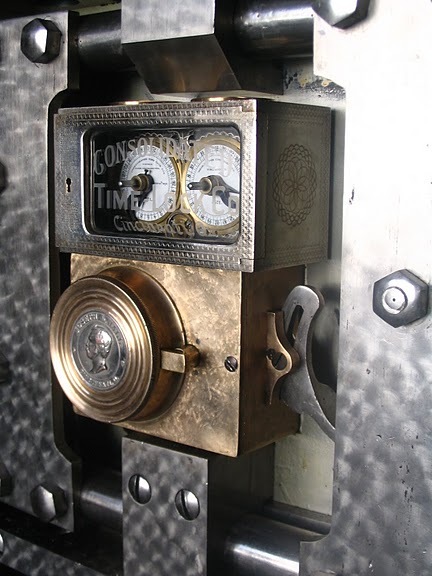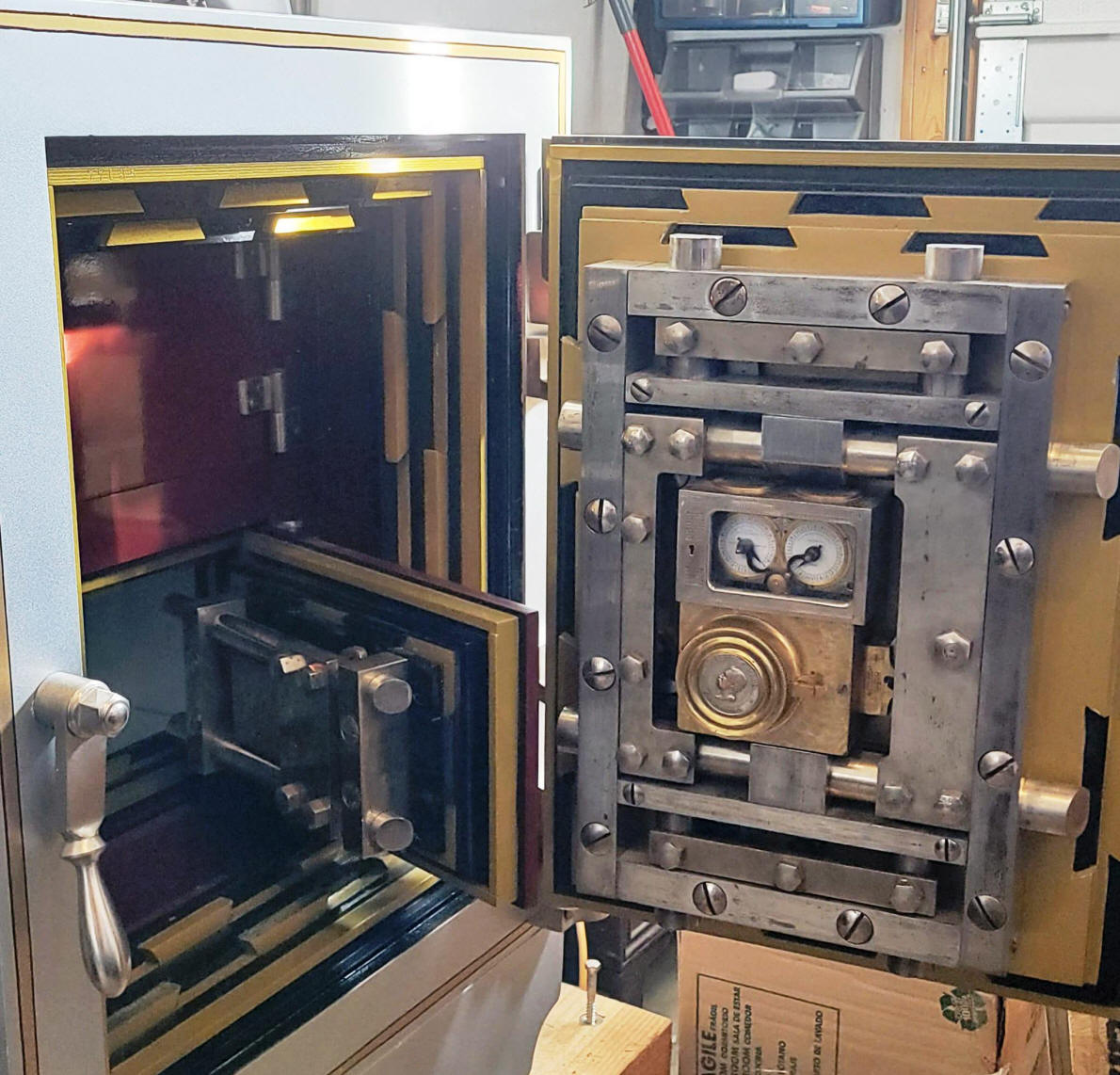Consolidated Time Lock Co., Cincinnati, Ohio - 2 movements
A
This video shows a consolidated time lock featuring a limited
intraday locking capability advertised by Hall's and later the Consolidated as
their Infallible Chronometric Attachment™. The movement on the right is equipped with an
optional rotating arm that can be set ahead of the time that the lock would
normally go off guard. This arm when contacting the bolt dog, or in this case
combination lock dog, will put the lock on guard. In this way if one wanted to
leave the bank early, but still want the time locks to go off guard at the same
usual time the next day, one could set the arm to any number of hours ahead or
to just about immediate to coincide when one wanted to leave. It allows one to
preset the time lock before closing time.
This was a fairly limited intraday capability compared to Yale Model #1 which
had a multiple intraday function. It's advantages were the simplicity of setting
as well as the fact that Consolidated could add this feature on an ad-hoc basis
with a rather inexpensive simple ratchet and arm assembly mounted to the
existing right hand movement. Whereas other time lock designs had to incorporate
this function directly into the design of the lock.
One could adjust the pointer to allow the time lock to go on guard at any hour before the normal time that the safe would go off guard. For example, one could set the pointer for three hours from whatever time the time locks were currently running, lock the safe and be sure that no one else could open the safe even with the correct combination until that time. This could be done only once until the right hand timer ran out to the desired time before being reset. Another example of intraday functionality is the very complex Yale #1 which allowed one to do this exercise this capability to within one hour throughout a 24 hour period!
This is an example of one of the first time locks made by Joseph Hall under the newly incorporated Consolidated Time Lock Co. in 1880. Hall needed a separate corporate entity to manufacture time locks in order to shield his existing safe and vault business from the litigious environment that surrounded the time lock business at the time. The company began operations in January 1882. This time lock can be accurately dated to 1882 because the case is slightly wider by about a three-quarter inch from all models produced after October of 1882. The forty-eight hour movements in these early time locks have a concentrically circular engine turning on the front plates, which was later replaced by the more common wavy vertical damascening. One hundred of this model were made but only two of the earliest wide-cased Consolidated time locks are known to survive. This is also the only wide cased example known to have the elaborately hand engraved side panels and floral engraving. This type of engraving was found sporadically on Consolidated and Dalton (also part of Hall's Safe & Lock Co.) cases from this period continuing though about 1886. The theme to the engravings may be the Ohio River region with subjects known to include sail boats, ducks, cranes, hunting dogs, boys fishing, and a country gentleman with a fishing rod. One can easily imagine that Mr. Hall was an avid outdoorsman and had his favorite activities immortalized on a few of his special time lock cases. The work may have been done by the same artist given the consistent appearance of the associated floral vine engraving. Eight folk art engraved examples are known. Later side panels were machine engraved in a circular guilloche pattern. This is the same lock as featured in John and Dave Erroll's book, pages 214-217. (1) The lock also has an optional intraday locking device located on the right hand movement allowing the operator to automatically put the lock on guard at any time. In this way one could leave the safe alone earlier than usual with the lock going off guard at the normally set time. See video above for a full explanation of this device. 5 7/8"w x 3"h x 2 5/8"d. Case #3021 stamped on rear with #228 stamped on door, movement #3021. file 204
B
B. This lock employed the rare E.J. Woolley patent design that allowed the firm's time lock to operate in the more conventional manner, that is on the safe's automatic bolt work instead of the combination lock, c. 1886 . This allowed for it to be used alone without a key or combination lock as was becoming popular at the time. The lock is also equipped with the rarely seen optional longer duration, 78 hour movements. Fewer than 100 were made between 1886 and 1887 and only four complete examples as shown above are known to survive.(2) Case#6412, movement #6412, all bolt work parts #73589. file 121
The photos below show a Consolidated time lock on three different safe doors. The first two safes have the time lock acting upon the combination lock. The last photo shows the same type of time lock attached to a Consolidated bolt motor which allows the time lock to trip the motor and automatically throw open the bolt work. This eliminated the need for a combination lock, or a manual bolt crank; leaving the surface of the door completely solid. This eliminated the openings needed for a combination lock and bolt crank which could be used by a competent safe cracker as a venue to undermine the safe's security. The downside to this design is the fact that the safe is automatically opened at the appointed time and anyone present at that time can open the safe. So this type of configuration only worked in a secure environment.
The last illustration was included to show the unusual sideways mounting of the time lock as well as a very large single-cased dual combination lock. Normally, larger-sized, dual dial arrangements would be two separate cases of single dial combinations locks connected together externally rather than internally within one enclosure. If one looks carefully this is the very old style of Hall time lock as the door has the scalloped corners as shown here. The photo was taken from a publication issued for the 53rd Congress, 1893. Report to Secretary of the Treasury on Improving Vault Facilities of the Treasury Department. It is a primmer on safe cracking and a fascinating read on how many ways and how quickly a talented safe cracker can open nearly any safe made in the day. This photo was taken after several 4" holes had been drilled to demonstrate that such a hole can be made using a hand drilling apparatus in under four hours. The publication even shows how one can make liquid nitroglycerine from dynamite! The one model of safe that was impervious to safe cracking within the time necessary before the normal opening of the business was the Corliss planet safes.






(1) American Genius Nineteenth Century Bank Locks and Time Locks, David Erroll & John Erroll, pp 214-217.
(2) American Genius Nineteenth Century Bank Locks and Time Locks, David Erroll & John Erroll, pp 228-229.